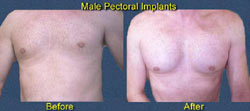Men frequently find that even with exercise, they are unable to achieve the chest development that they desire. This has led to the demand for the operation known as pectoral implantation. Originally developed in response to request by body builders, the operation is now requested by many individuals who are simply uncomfortable with the appearance of their chest. The operation is useful for men with less than normal chest development or for men who are simply unable to achieve the chest size they desire with maximum exercise. It can also be used for men with underdevelopment of the muscles of one side of the chest as a result of congenital defects or injury. While far less popular than breast augmentation in women, the operation is highly satisfying for many individuals.
 Surgery is under general anesthesia and involves a small incision in the armpit. Through this incision, implants are inserted beneath the chest muscles. At our Center, the preferred method is through an endoscopic approach, using telescopes and video cameras to assure precise dissection with minimal risk of bleeding for infection. This also allows smaller incisions and more accurate placement.
Surgery is under general anesthesia and involves a small incision in the armpit. Through this incision, implants are inserted beneath the chest muscles. At our Center, the preferred method is through an endoscopic approach, using telescopes and video cameras to assure precise dissection with minimal risk of bleeding for infection. This also allows smaller incisions and more accurate placement.
The implants used by Dr. Howard Tobin are made in various sizes out of a very soft, but solid silicone rubber. The goal of the procedure is to achieve a natural-looking contour of the male chest. They are held in place by the overlying pectoralis muscle. The muscle function itself is not disturbed, and patients can continue to exercise or work normally after healing. Unlike the saline filled implants used for women, these implants feel fairly firm which is desirable for the male chest.
RECOVERY AND RISKS
The operation is performed on an outpatient basis under general anesthesia. No dressings or drains are required. Patients should anticipate considerable soreness for the first few days after surgery. It will take a week or so to resume normal activity and full activity is restricted for up to six weeks.
The risks are similar to those of breast enlargement in women, except that there is no risk of capsular contracture or deflation, since the implants are not filled. Since these are the most common problems following augmentation with saline filled implants, male chest enhancement is less likely to require secondary surgery. Bleeding, requiring secondary surgery, and displacement, which could require further intervention, are the most common complications. Infection, while possible, is quite uncommon, but could require removal of the implant.

